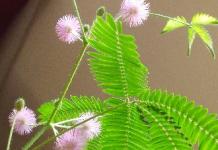Mimosa pudica is a plant belonging to the legume family. Previously, this decorative home flower belonged to the Mimosa family, but then this family was disbanded. Shy mimosa differs from other varieties of indoor plants in some unique features, which makes it an interesting decoration for an apartment or cottage.
It should be understood that there is a big difference between a house plant and what everyone is accustomed to calling mimosa. So the latter is an ordinary tree, and in other words is designated as silver acacia. The height of this huge tree can reach 12 meters, while mimosa is a small flower that grows in ordinary houses and apartments.
The plant can reach 60 centimeters in height. Its stems are prickly and its leaves are feathery, growing up to 30 centimeters. Mimosa bashful blooms from the beginning of June until September with spherical inflorescences, visually resembling a pompom made of threads. Their diameter is 15-25 millimeters, and the color is light purple.
However, shy mimosa can also be wild. In nature, this attractive shrub is completely similar in its characteristics to a house plant. However, you can’t find it in this form everywhere, but only in South America (mainly in Brazil) and Australia.
Mimosa pudica is a plant belonging to the legume family.
History of the name of the plant
The key feature of this plant is its increased sensitivity to physical influence. A small touch to the mimosa pudica is enough for its leaves to fold and its branches to droop. This happens for about half an hour, after which the leaves acquire their original appearance.
A similar picture is observed with the change of day and night. During daylight hours, the leaves are straightened, and during the dark they fold. However such “experiments” on the plant should not be abused, after all, excessive irritation of the sensitive hairs of mimosa pudica leads to its depletion.
Because of its interesting physiological characteristics, the plant received the prefix “bashful”. As for the name “mimosa” itself, translated from Greek it means “imitator”.
Gallery: mimosa bashful (25 photos)




























Features of caring for mimosa pudica (video)
Technology for growing mimosa pudica from seeds
This indoor beauty can also be propagated through cuttings, but they are accepted only in half of the cases. It is for this reason that seeds, which germinate very quickly, are most often used to propagate Chinese mimosa. Material for planting can be purchased at the store or collected from another flower.. In the second case, you need to connect two inflorescences together, and then shake the flowers a little, and wait for the fruit to set.
Requirements for soil and flower pot
For planting, as well as subsequent replanting, you can take absolutely any soil intended for beautifully flowering plants. It is only important that the soil you choose is loose and enriched with nutrients. If you want to prepare the soil yourself, then you need to mix well:
- 4 parts soddy clay soil;
- 2 parts each of deciduous soil and peat;
- 1 part sand.
The pot needs to be small. It should contain one or more holes at the bottom to drain excess water. For the same purpose, a small layer of pebbles or nutshells is poured onto the bottom of the pot.

The pot for mimosa pudica needs to be small in size.
Selection and preparation of planting material
Mimosa pudica needs to be renewed annually (perennial plant species also exist, but are not found often and, usually, only in greenhouses). Seeds can be purchased at any flower shop, as noted above, or collect it yourself. However, regardless of the option you choose, you need to sow the seeds between February and April.
Features and timing of planting
2-3 months (approximately May-June) after sowing the seeds, the seedlings need to be transplanted to a permanent place. If you don’t have a small pot, then You can plant several plants at once. This way you will get a very attractive decoration for your home, and provide good conditions for the growth of mimosa pudica.

2-3 months (approximately May-June) after sowing the seeds, the seedlings need to be transplanted to a permanent place
Next steps
Additionally, you need to take into account the following nuances:
- The plant does not like drafts.
- Stretching stems indicate a lack of daylight.
- Some people may experience an allergic reaction when mimosa pudica is in bloom.
- If your actions lead to frequent folding of the mimosa, then it will quickly become depleted and die.
Growing mimosa pudica from seeds (video)
What does mimosa pudica need to bloom?
After planting a plant, there may be no growth and/or no flowering for a long time. If you are faced with such a situation, then this is most likely due to unfavorable conditions created for mimosa pudica. Perhaps the plant lacks light, nutrients in the soil, heat or moisture. Irregular watering can also cause leaves to yellow and fall off, and overly wet soil will prevent them from opening.

Irregular watering of mimosa pudica can cause leaves to turn yellow and fall off.
Caring for mimosa pudica at home
This plant is very delicate and demanding of the conditions around it. It can suffer not only from excessive physical impact, but also due to the unfavorable conditions in which it is located.

It is best to place mimosa pudica near windows facing south.
Choosing a place in the house
It is best to place the plant near windows facing south. If you don't have one in your house, then you need to find a place where the mimosa will receive enough light and heat. But in apartments whose windows face only the north side, the plant may well not take root, which needs to be taken into account.
Temperature, humidity, lighting
The room in which mimosa pudica will be located should be moderately warm. The most suitable temperature for plant growth will be 22 degrees (possible deviation in each direction is no more than 2-3). In winter, when mimosa is at rest, a decrease to 13-16 is allowed. But It is strictly prohibited to provide dry and hot air to mimosa pudica. In such conditions, the plant can die very quickly.

Humidity indicators play a very important role for home mimosa.
Humidity indicators play a very important role for home mimosa. They should be between 70 and 85%. For this it is necessary to constantly spray the air around mimosa pudica. However, this should only be done around it, without spraying it on the plant itself, so as not to disturb its leaves again.
Lighting, as noted above, should be very good. Mimosa pudica is a tropical plant, so it desperately needs sunlight. If, due to the location of the apartment, it is not possible to provide a sufficient amount of it, then you can purchase special lamps.
Watering the plant
From approximately April until mid- or late autumn, regular but moderate watering should be provided. In winter, their frequency should be reduced to a minimum (about once every 6-8 days). The plant does not tolerate too hard water, so it is better to filter it before watering or buy suitable water in regular or flower shops.

Regular fertilizer for the flower is very important
Top dressing
Regular fertilizer for the flower is very important. The plant experiences the greatest need for feeding during the flowering period, which occurs at the end of summer and beginning of autumn. Sometimes the formation of inflorescences can begin in the spring, and already at this time you need to fertilize mimosa well. The procedure needs to be carried out 2-3 times a month, for which you can use ready-made liquid fertilizer for beautifully flowering indoor plants.
This perennial herbaceous plant, 30 to 150 cm in height, originates from tropical areas of South America, where it is considered a weed; At the same time, it is cultivated all over the world as a decorative plant.
Mimosa blooms from May to September with small purple inflorescences in the form of balls, which are located on long peduncles. Pollination occurs with the help of wind or insects; after flowering, hook-shaped, curved beans are formed.
A distinctive feature of Mimosa pudica is its reaction to a potential threat. When the roots are damaged, the plant releases a “cocktail” of toxic substances, including methanesulfonic, lactic, pyruvic acids and various sulfur compounds; This often leads to poisoning of livestock on pastures.
Another amazing property that gave the plant its name was its ability to curl its leaves in response to touch. The mechanism of this action is known to scientists. There are water membranes at the base of the petioles, and sensory areas on the leaves respond to pressure. When touched, water rushes to the point of contact, and under this weight the leaves curl and fall down. Recently, Australian scientists discovered that mimosa pudica is capable of self-learning. According to the results of a study published in the journal Oecologia, mimosa “remembers” the characteristics of each contact and if it does not pose a threat, it will not waste energy on folding its leaves. This behavior is characteristic of animals: with the help of the nervous system, they not only receive information, but can also use it in the future. The behavioral response of the plant, taking into account the data it has accumulated, was described for the first time using this example.
A new study was conducted by specialists from the State University of New York at Albany. They learned that the bashful mimosa is good at distinguishing its potential enemy. During the experiments, it was established: in those cases when a person touched its roots, the air was filled with a mixture of hydrogen sulfide and other substances, while contact with metal, glass and other objects did not trigger the mechanism for producing “chemical protection”.
As a result, biologists found another conceptual difference between Mimosa pudica and other representatives of the fauna: if most plants that use poison for their protection secrete it from their above-ground parts, then the object of their study does this with the help of its roots, on which tiny nodules are located. Moreover: they not only produce poison, but also analyze the chemical composition of the environment, “making decisions” about potential danger.
Gorgeous, incredible, beautiful - all these words of praise can be said about the calathea flower. She came to our greenhouses on the windowsills from South America. This incredible flower belongs to the arrowroot family, so it needs to be properly cared for.
The name “calathea” is consonant with the name of the well-known Galatea, which was sculpted by the sculptor. Many believe that the flower owes its name to this girl, but everything is much more prosaic: once upon a time, wild tribes living in South America used calathea leaves to weave baskets. Its name literally translates as basket. Craftsmen used various leaves to create beautiful patterns for their baskets.
Orthodox people also fell in love with this tropical flower because it beautifully folds its leaves at night, creating a feeling as if it were two palms folded as if during prayer. People call the arrowroot family the Bogomolets. Caring for such a miracle of nature at home is very interesting.
How not to destroy a plant and grow it beautiful, it is enough to create a climate at home that is close to its native one and organize proper care. By following simple care rules, you can easily achieve maximum results at home:
- Watering and fertilizing;
- Lighting;
- Temperature;
- Replanting and proper soil;
- Breeding.
Of course, it’s not entirely customary to do something that is not typical in our latitudes, but you can create a small arboretum at home; for this purpose, it will be enough to start with several varieties of Kalati.

Watering
 In summer, calathea requires abundant watering; in addition, it is necessary to provide the maximum amount of moisture for the flower - this is one of the main rules that require care. It is advisable to spray the calathea and place a tray with wet expanded clay near it. Fertilizers should be applied once every 2 weeks. They should be added after watering. If the dried soil is immediately watered with fertilizer, the calathea may die. Calathea must first receive moisture, and only then fertilize.
In summer, calathea requires abundant watering; in addition, it is necessary to provide the maximum amount of moisture for the flower - this is one of the main rules that require care. It is advisable to spray the calathea and place a tray with wet expanded clay near it. Fertilizers should be applied once every 2 weeks. They should be added after watering. If the dried soil is immediately watered with fertilizer, the calathea may die. Calathea must first receive moisture, and only then fertilize.
In winter, the flower should be watered moderately, but due to the heating being turned on, the air becomes dry - this is unacceptable for a tropical beauty, so you can spray it in winter or wipe the leaves with a damp sponge.
Lighting should be sufficient all year round, calathea lives thanks to it, in addition, the beauty of its leaves depends on the quality and quantity of lighting. At home, caring for calathea is not difficult for experienced flower growers who have all the necessary lighting devices.
Direct rays of the sun are contraindicated for her, but bright diffused light is her life. If possible, it is best to display this curiosity on windows facing western and eastern directions. If this is not possible, additional lighting should be provided or, if necessary, shaded from the sun.

Temperature
The flower loves warmth; at home you should not place it in drafts. It is necessary to provide such care for the calatay so that the air temperature never drops below +18 degrees.
Calathea also does not like sudden changes in temperature, so if it stands in one place and is comfortable for it, you should not move it.
Transplantation and soil selection
All flowers that grow in the tropics or in mangroves must select a substrate containing peat and sand. They prefer moisture. But they don’t like stagnant water. When replanting, you need to mix ordinary soil (two parts) with peat (one part) and sand (one part). At home, such soil will be ideal for the growth of calathea.
It is advisable to choose a shallow pot, but a wide one. Since the root system of arrowroot grows under the surface of the earth, but does not go deep.
Calathea must be replanted as it grows. As soon as the entire pot is hidden under the leaves, this is a sign to change the flower bed.

Breeding
Calatheas bloom, but compared to the leaves, their flowers are small and do not represent any aesthetic value for lovers. Pollination under natural conditions occurs in a rather interesting way. Quite small bees fly up to flowers, stick their proboscis into the middle of the flower to collect nectar, and from there, thanks to their cunning structure, pollen shoots out. The insect carries pollen, thus pollinating flowers.
At home, calathea is best propagated by dividing the root shoots. When transplanting, new shoots will be visible; they must be separated from the mother and planted in a separate pot, which must be cared for again. If there are a lot of shoots and you don’t want to get carried away with dividing, you need to remove three or four new flowers and that’s it.
Mimosa pudica is one of the plants that is easy to grow, but requires some effort. It can be grown as an annual or perennial plant. But in the latter case, it can become very stretched and lose its decorative effect. But you can remove seeds from it every year and replant for the next growing season.
Did you know? A characteristic feature of the plant is that it curls its leaves from a light touch, shaking, strong wind or warming. Scientists called this phenomenon seismonasty. If you remove the external irritant, after 20 minutes the leaf opens again. Scientists cannot say for sure why the plant developed this property. Probably to repel pests and herbivores.
Description of the mimosa flower
The plant is classified as an ornamental shrub native to Brazil, but today it is widespread in many countries around the world. Belongs to the Mimosa family. The bush has straight stems studded with thorns. It grows on average up to 30-60 cm, but in its natural habitat, the subtropics, it can grow up to 1.5 m.
Important! The plant is poisonous, so make sure that pets do not eat it and be careful with it.

The entire plant is covered with whitish fluffy hairs. The sensitive leaves are bipinnate and close not only when touched, but also at night. Flowers of lilac or pink color are collected in spherical inflorescences. They are pollinated by insects or wind, after which they form fruits - pods containing 2-8 peas.
Optimal conditions for growing mimosa pudica
In our region, mimosa pudica is grown from seeds and cultivated as a houseplant. The success of cultivation depends on the right conditions.
Lighting
The plant is light-loving, therefore it should be placed on the south side, choosing the brightest place in the room. Some direct sunlight during the day is acceptable.
Important! During flowering and after the inflorescences fall, a large amount of pollen, which is considered a high allergen, spreads from the plant into the air. People prone to seasonal allergies are not recommended to grow mimosa pudica flower at home.
In winter, due to lack of light, mimosa pudica may stretch out and lose its decorative properties. In this case, it can be heavily pruned in the spring, and over the summer it will restore its appearance. But it is better to prevent this by organizing additional lighting in winter.
Temperature
 The ideal temperature at which the flower develops well is 20-24 °C. This rule applies to the summer period, when the plant is actively growing and producing flowers and fruits. In winter, during the dormant period, mimosa pudica should be kept at room temperature not lower than 16 °C.
The ideal temperature at which the flower develops well is 20-24 °C. This rule applies to the summer period, when the plant is actively growing and producing flowers and fruits. In winter, during the dormant period, mimosa pudica should be kept at room temperature not lower than 16 °C.
Features of caring for mimosa pudica at home
Mimosa pudica is unpretentious to care for at home. If you follow all the recommendations described below, it will delight you with flowering for four months.
Important! The flower is extremely sensitive to tobacco smoke. One contact is enough for the bashful mimosa to drop all its leaves.
Watering and air humidity
If a mimosa has settled in your house, care and cultivationIt starts with proper watering of the plant. From spring to autumn, it requires abundant watering, but so that the water in the pot does not stagnate. In winter, during the dormant period, the number of waterings should be reduced to approximately once a week. Only use soft water.
 The flower loves high air humidity, approximately 75-85%. It is especially difficult to maintain such indicators in winter, when the humidity drops sharply during central heating operation. This is why mimosa often dies during the dormant period. To prevent this from happening, it is recommended to place bowls of water next to it or spray it.
The flower loves high air humidity, approximately 75-85%. It is especially difficult to maintain such indicators in winter, when the humidity drops sharply during central heating operation. This is why mimosa often dies during the dormant period. To prevent this from happening, it is recommended to place bowls of water next to it or spray it.
Important!It is necessary to spray only the air around the plant. If drops fall on the leaves of a mimosa, she will immediately fold them.
Soil and its fertilization
For growing mimosa pudica in a pot Almost any soil for ornamental plants is suitable. It should be loose, nutritious, but contain as little peat as possible. You can prepare the mixture yourself by taking part peat, part deciduous soil, two parts clay-turf soil and half part sand.
The plant must be fed regularly, especially during the period of active development and flowering. It is ideal to fertilize approximately once a week throughout the growing season. It is enough to use a special liquid fertilizer for ornamental plants.
Did you know? The plant's leaves have been observed to move over time. The first to discover and record this phenomenon was the French astronomer de Meirin in 1729. The movements were called nyctinasty. They have a certain periodicity and are not affected by light. It is assumed that the movements are related to the biorhythms of the Earth. The Swiss biogeographer and botanist Alphonse Decandolle in 1832 proved through experiments that these movements occur at intervals of 22-23 hours.
 The soil of mimosa pudica needs to be loosened periodically, but otherwise the question of how to care for the plant is solved in the same way as with other ornamental plants. The only thing, The plant must be replanted after wintering, and also as needed during the growing season: during treatment or in case of soil rot.
The soil of mimosa pudica needs to be loosened periodically, but otherwise the question of how to care for the plant is solved in the same way as with other ornamental plants. The only thing, The plant must be replanted after wintering, and also as needed during the growing season: during treatment or in case of soil rot. Difficulties in growing: diseases and pests of mimosa pudica
The flower is little susceptible to disease. Most often, he suffers from an ailment such as wilting leaves. This is usually due to lack of moisture. Will help solve the issue spraying the air around the plant and regular watering.
If the air is too dry, the plant may be attacked by spider mites. Then, in addition to equalizing air humidity, mimosa must be treated with acaricides such as "Aktellik", "Sunmite", "Omite". Under the same conditions, aphids may appear. To combat it, systemic insecticides must be used.
Growing mimosa pudica from seeds at home
 The plant reproduces not only by seeds. You can also use cuttings, but they have a low survival rate. That's why It is still safer to use the first method, especially since mimosa seeds germinate quickly. You can buy them in the store, and if you already have an adult plant, you need to pollinate it and wait for the fruits to set. When the pods are completely dry, they are collected and placed in a paper bag, which is stored on the refrigerator door.
The plant reproduces not only by seeds. You can also use cuttings, but they have a low survival rate. That's why It is still safer to use the first method, especially since mimosa seeds germinate quickly. You can buy them in the store, and if you already have an adult plant, you need to pollinate it and wait for the fruits to set. When the pods are completely dry, they are collected and placed in a paper bag, which is stored on the refrigerator door.
Sowing is carried out in late February - early April. Take the seeds out of the pods and pour hot water over them for half an hour. Planting containers are filled with disinfected and moistened loose soil. The seeds are immersed in it to a depth of about a centimeter. The sowing is covered with polyethylene or glass and placed in a warm place so that it is not exposed to direct sunlight. The air temperature should be at least 20 °C, and preferably about 25 °C.
Mimosa pudica is native to the southern subtropical regions of America. Its natural habitat is its homeland and Brazil. This genus contains more than 500 species.
One of them is the “bashful” mimosa, or, as it is called, “impatiens,” which is grown at home.
This plant got its name for the ability of the leaves to fold and fall down at the slightest mechanical impact, as if embarrassed by something.
Description of the species
Mimosa pudica at home is an annual, beautifully flowering herbaceous shrub. This is an evergreen plant 30-40 cm high. The stems are branched and very light.
They are covered with spines that resemble fine hairs. The numerous leaflets of light green, double-pinnate leaves are always curled and drooped at night, and during the day - only when exposed to pressure.
After a certain time, in a state of rest, the leaves unfold.
Attention!
Mimosa pudica is a tender plant. The flowers are pink or lilac. They are collected in small fluffy spherical heads. They bloom for 2-3 days and fall off. The fruits are formed on the ovaries during self-pollination of the plant and have the appearance of beans.
They are not eaten; their poison can cause poisoning. The flowering period is long: it begins in summer and ends in autumn. Mimosa is sometimes confused with silver acacia, which is a member of the Mimosa family but is not a plant of that name.
The main difference is that its flowers are yellow.
Growing
Mimosa pudica prefers well-lit places at home. She does not like wind, drafts and foreign odors, especially tobacco smoke. In a smoky room, its leaves curl and fall off. The best temperature for it in the summer is considered to be 20-25 degrees, and in winter 16 is enough. The shrub loves moisture, but in moderation.
In spring and summer, it needs to be watered regularly and abundantly; in extreme heat, sprinkling should be done. And in winter, when the plant is resting, it is enough to monitor the condition of the soil and prevent it from drying out. Water as needed. Overmoistening can lead to loss of decorativeness. Mimosa pudica grows better on loose, fertilized soil.
Growing from seeds makes it possible to obtain many shrubs at the same time.
For fruit to set, the plant must be pollinated. You can carry out this process yourself. It is enough to transfer the pollen with a brush or soft swab. After this, a pod begins to form.
When it is ripe and dry, it is picked and placed in a paper bag. The pod will be stored in it all winter, until spring.
It is important to remember that this plant is difficult to preserve in winter; it dies.
Transfer
Mimosa pudica grows at home as an annual; there is no need to replant it. If necessary, this is done in the following cases:
- When the bush is left for the winter and grown as a perennial plant.
- If the “touch-me-not” gets sick or the soil begins to rot.
Transplantation should be done using the transshipment method. The plant is placed in a larger pot along with a lump of earth. First, the bottom of the pot is covered with pebbles, which will serve as drainage. The soil is prepared in advance. The earth is mixed with sand, peat and rotted leaves. It is better to replant shrubs early in the morning or in the evening, when the sun has set.
Description and rules for caring for Mimosa pudica
Also check out these articles
Mimosa pudica is a herbaceous (semi-shrub) plant from the genus Mimosa, the legume family. Height – from 30 cm to 1.5 m.
It is native to Brazil, but as an alien plant it is also found in other tropical countries.

The stem is straight, has spines, the bipinnate leaves are very sensitive, fold when touched and at night.
The entire plant is covered with small, whitish hairs. The flowers are small, pink-lilac, collected in spherical inflorescences. In nature, mimosa pudica is pollinated by insects and wind.
You can try to get the fruits in culture, but you will need to make some effort. If this is successful, the inflorescence will go down, the place of its attachment to the plant will thicken and, after a certain time, a pod with seeds (from 2 to 8 pieces) will form in place of the inflorescence.
Sometimes in the literature there is an opinion that it is not recommended to keep mimosa at home for people with pollen allergies, since a normally developed plant during the flowering period will provide the owner with a huge number of fallen inflorescences and particles of microscopic pollen in the air.
Usually, mimosa pudica, popularly called “sissy,” is grown from seeds for fun. It is equally difficult for both children and adults to resist the desire to touch it.
Depending on the intensity of the impact, mimosa pudica responds by folding along the central vein or, in addition, lowering the entire leaf along the stem. Within 20 minutes, in the absence of irritants, the sheet rises and opens back.
This unusual skill often leads to death from depletion of energy reserves; the mimosa cannot hide and straighten out endlessly, and the people caring for it cannot stop in time.
How to water and light a plant?
Maintenance is relatively easy. But mimosa has a special weakness - it is so sensitive to tobacco smoke that it immediately drops its leaves. If you follow all the recommendations, mimosa will thank you with dim but exquisite flowering. In favorable conditions, it blooms for about 4 months.
Lighting. Provide her with the brightest spot you can find in the house with some direct sunlight. In winter, indoor plants especially suffer from lack of light. This leads to the fact that the mimosa stretches excessively, losing its decorative effect (in the spring, with the onset of bright sunny days, the plant can be cut quite short in order to make it compact).
Watering. During the growing season, i.e. from spring to autumn, mimosa needs abundant watering (but do not overdo it), as well as fertilizing with fertilizers. Water sparingly in winter. Use soft water for watering.
The air humidity should be sufficient so that the mimosa does not suffer from dryness. Dry indoor air from heating also worsens your well-being. This is why sensitive mimosa often dies in the autumn-winter period. To prevent this nuisance, you can place bowls of water near the plant.
If you increase the humidity by spraying, then spray not the leaves of the mimosa (since it will begin to fold leaves), but only the air around it.
The temperature during the period of active growth should be at 20-24 degrees. In winter - at least 16 degrees.
Transfer. Rarely does anyone replant mimosa pudica. More often they propagate it by seeds, because many consider mimosa to be an annual crop.
When are Mimosa seeds sown?
The information is largely contradictory on this matter. Some sources indicate that mimosa is a perennial plant by nature, and as an annual it is grown only in open ground.
But still, flower growers who have this wonderful plant in their collection re-sow the seeds in the spring. Some people do this because their mimosa dies in winter. And others - because mimosa loses its decorative qualities in winter (the stems become very elongated due to lack of light).
Reproduction. It can occur either by seeds or cuttings. But cuttings are not always accepted - 50/50. Therefore, mimosa, as a rule, is propagated by seeds, especially since they sprout quite quickly.
You can always buy seeds at the store or try to collect them from your plant. To do this, you need to touch one flower to another (shake them a little) and wait for the fruit to set.
Mimosa fruits are in the form of pods (since the plant is from the legume family). The pods are harvested when they are completely dry, which means the seeds are ripe. Ripe seeds look like flattened peas of black or dark brown color. Place the collected pods in a paper bag and store them on the refrigerator door until spring.
From March to April you can sow seeds. Before sowing, gut the pods and pour hot water over the seeds for 20-30 minutes, so they will sprout faster. For sowing, take steamed peat or any loose, moistened soil mixture.
Do not deepen the seeds too much; just stick them 0.5-1 cm into the soil. Cover the bowl with seeds with glass or a plastic bag for a greenhouse effect, and place it in a bright place, but not in direct sunlight. Maintain the air temperature around 24-26 C, but not lower than 20 C.
Shoots should appear in 1-2 weeks, but for many they appear on days 4-5. Apparently it depends on how favorable the conditions are.
When the seedlings reach a height of 5 cm, plant them in plastic cups with a mixture of 2 parts garden soil, 1 part sand and 1 part peat.
Diseases and pests of mimosa pudica
The main pest is the spider mite. If you notice signs of infection, treat the area with acaricides (Omite, Sunmite, Actellik), observing safety precautions. Aphids may also appear. In this case, use systemic insecticides for treatment.

Reproduction of Mimosa pudica by seeds
Mimosa pudica Mimosa Pudica propagates very well indoors by seeds.
Mimosa pudica is a tropical plant that is grown indoors as an annual and is cultivated only as a fun plant.
Erect stems can reach 70 cm in height, and the flowers appearing at the ends of the shoots are 2 cm in diameter and have a pink-purple color. Usually mimosa blooms are observed in the summer, but mine is not going to bloom yet.
Mimosa seeds can be purchased in bags. They are slightly flattened peas, in a glossy dark brown or black shell-shell. You can sow the seeds of mimosa pudica from the end of February to the end of April; it is grown in seedlings. Any loose soil mixture is suitable for sowing, and for successful germination of seedlings, a temperature of at least 20, or even 26 degrees is required.
Under such favorable conditions, seedlings will appear quite quickly - in one to two weeks. Before sowing, the soil should be well leveled and moistened. It is recommended to scald mimosa seeds before sowing, but without this procedure I simply spread them on the surface of the soil and lightly sprinkled them, without compacting them, with a layer of dry soil up to 0.5 cm. Covered them well with film to retain moisture and create a greenhouse effect.
For the development of Mimosa pudica seedlings, they need heat, light, and air humidity of 75-85%. My seedlings sprouted very well, because I sown the seeds in a plate with drainage holes and a drainage layer, and covered them with a transparent plastic bag.
From the book descriptions it was clear that this was an easy plant to grow and care for, but after the heating in the house was turned off, many seedlings fell ill with blackleg and died due to lack of heat.
With the onset of warm nights at the end of May, I planted the remaining seedlings in the phase of three true leaves (the height of the plant was 5-6 cm) into a pot and took it out to the balcony. The roots of mimosa pudica are very delicate, like the plant itself.
Despite the fact that mimosa loves bright light and some descriptions in books that it tolerates a short stay in direct sunlight, my mimosa, being in the sun from morning to noon, received burns: the complex feathery leaves of the mimosa began to dry out and crumble in the heat.
It requires timely watering in dry weather and spraying the seedlings with warm water. Mimosa develops relatively slowly and gains height very little: when the plant grows 13 cm, the thickness of the reddish stem is about 1 mm.
Now the mimosa has several spreading leaves, and one bush has recently suffered from a common aphid. The attack of an ordinary green aphid, which often happens on roses, dealt a cruel and irreparable blow - only one dry stem remained from the plant, all the leaves were destroyed.
It is likely that outdoor conditions are not entirely suitable for it, and it is possible that mimosa would have developed much more actively and faster if it had been indoors. And although it has been growing for about six months, by all indications it is not going to bloom at all.
But it’s a pleasure to play with it; when you carefully touch the mimosa with a thin match or stick, it instinctively folds the leaves and lowers the cuttings down, taking on a completely unattractive appearance. Therefore, growing mimosa will be an interesting and exciting process for families with children.
Attention!
True, she can get a lot out of them, even if we adults sometimes torture our mimosa for fun. But do not confuse mimosa bashful with mimosa, which is given to us on March 8th.
Pests and difficulties
Seeds are used either purchased or grown independently, taken from mature fruits. In early spring, the pod is opened and the seeds are removed. Do not use substrate components from open sources, without pre-treatment, they contain many bacteria and microorganisms that negatively affect seedlings.
Use small bowls with a hole in the bottom. First, a layer of expanded clay is laid on the bottom as drainage.
The environment must always have high humidity and a temperature of 25-30 degrees. Mimosa pudica has very fragile and delicate roots; be extremely careful when diving.
The most amazing feature of Mimosa pudica is that it curls its leaves with a light touch.
Mimosa pudica is an evergreen ornamental shrub native to the subtropics of South America. The bashful mimosa gained its popularity due to its bizarre property of reacting to any touch, even a light wind. She immediately begins to fold her leaves.
How to properly grow mimosa pudica from seeds

A native of the South American tropics, the bashful mimosa quickly won the hearts of gardeners, but not because of its ball-shaped inflorescences, vaguely reminiscent of the single flowers of a real mimosa, but because of its “muscular” leaves.
Nature is a master of surprise, but the bashful mimosa is truly a masterpiece from the world of flora - it delights even the most experienced florist! Not a single plant will seem as “alive” to you as Mimosa pudica: all it takes is a light breeze, a drop of dew, or a touch, and the leaf immediately droops. After some time, the leaf (there are 10 or more pairs of leaf blades on the petiole, like in ferns) begins to smoothly return to its original position.
In tropical conditions, mimosa pudica does not have a pronounced period of physiological dormancy, but in our climate zone, alas, we have to grow it from seeds every year.
Of course, if you create favorable conditions (a greenhouse), then the bashful mimosa will grow, bloom, and even produce seeds.
But here you need to take into account that dry air, drafts and moisture condensation are destructive for the plant: “muscular manipulation” is nothing more than a stressful situation, which affects the health of the mimosa.
Growing mimosa from seeds at home
Mimosa pudica is easily propagated by seeds, which can be purchased relatively inexpensively in flower shops. And growing in an annual crop has the advantage that you don’t have to worry about fertilizing or taking up space on the windowsill with large flowerpots - ordinary half-liter plastic cups will do for mimosa.
Can't wait to see this "miracle"? – sow mimosa seedlings already in mid-February: at temperatures above 20 °C (optimum – 24 - 25 °C), seedlings will appear in 1 - 2 weeks, that is, in early March, when the length of daylight rapidly increases.
Mimosa pudica, like most tropical plants, prefers soils with an acidic soil solution, but tolerates “neutrality” well. Calcareous soils are not suitable for the plant, since calcium leads to immobilization of the “joints” (just like in humans!) and loss of leaves, which can lead to death due to impaired photosynthesis.
Seedlings dive in the phase of 2 true leaves, so you can choose a shallow container for sowing, up to 5 cm. However, you can do without picking if you sow 2 - 3 seeds in a plastic cup or flowerpot. In this case, you will have to cover each container (pot) with plastic film to ensure the required humidity level (about 80% is enough).
When seedlings appear, you must immediately remove the “greenhouse cover”, since the resulting condensation can provoke the disease “blackleg”. To maintain optimal humidity, it is necessary to place shallow containers of water near the seedling container, into which, to increase the evaporation surface, place a sea sponge (washcloth).
Important! Mimosa pudica prefers to grow in partial shade: with sufficient light, the leaf blades align horizontally, and with a lack of light, they bend in an arc towards the bottom to capture reflected ultraviolet light.
Mimosa pudica rules of care and cultivation from seeds
Mimosa pudica belongs to the genus Mimosa. It grows wild in Brazil and tropical America. Its height in nature can reach 0.5 meters.
Mimosa pudica has leaf blades located on the stem in pairs, and there are spines on the shoots and leaf cuttings. Nowadays, mimosa pudica is grown en masse in greenhouses as an annual plant.
Mimosa pudica can be propagated by cuttings and seeds.
Many people like not only to grow it on the windowsill, but also to play with it, as it noticeably moves its leaves when lightly touched. Mimosa pudica is grown in cultivation as an annual flowering plant. It has erect shoots and can reach a height of 0.70 m.
Flowers are formed with a diameter of 20 mm, lilac-pink, in summer, at the ends of the shoots. Mimosa pudica is a moisture-loving plant that has a negative attitude towards drafts. A mixture of peat, turf soil, sand and humus taken in equal parts is suitable as a substrate for mimosa pudica.
Attention!
Coarse perlite, sand and polystyrene foam can be used as leavening agents. It is also worth adding bone meal to the soil mixture, this will add nutritional value. For feeding, it is recommended to use complex fertilizer for flowering plants.
In order for mimosa pudica to set seed pods, which are the fruits of the plant, pollination is necessary.
Pollination can be carried out independently using a brush or a soft cotton swab, transferring pollen from the stamens of one flower to the pistil of a neighboring one.
After pollination, a pod with seeds is formed; when the pod is completely ripe and dry, it must be picked and placed in a signed paper envelope until spring. In spring, separate the seeds from the pod and sow after soaking them.
Mimosa pudica seeds are shaped like a flattened pea; the seeds have a dense, glossy skin. It is recommended to sow Mimosa pudica seeds in early spring in loose soil in furrows, followed by planting at the stage of 2 true leaves.
To germinate Mimosa pudica seeds, you need a room with a temperature of about 20 - 26 degrees. The soil must be moistened and, after sowing, covered with transparent oilcloth to create a microclimate with high humidity. Sowing is superficial, or it can be sprinkled with a fine substrate half a centimeter thick.
At the beginning of development, mimosa pudica needs warmth, light and high humidity of about 80%. The soil should be moist, but not waterlogged.
Overmoistening can provoke a disease called Blackleg, so a drainage layer and a sterile substrate are desirable; if there is any doubt about the sterility of the soil, it is recommended to spill it with a solution of potassium permanganate.
It is better to provide natural lighting on the window sill on the east or west side. It is recommended to cover the mimosa from the intense rays of the sun to prevent burns.
After the seedlings reach a height of 5 cm, they must begin to gradually get used to the open street air on the balcony or loggia. The seedlings do not tolerate drought, which can cause them to shed their leaves.
In addition to timely watering, you can pamper mimosa by spraying with warm water. Mimosa grows slowly. The stem is reddish in color.
Mimosa pudica has one attractive feature: with a light touch, its feathery foliage instantly folds along the main vein, and the stalk falls down. This plant takes on the same unsightly appearance when the sun sets. In the morning, the bashful mimosa straightens up.
Mimosa pudica: how to grow it correctly and what care it needs
One of the unusual indoor plants is mimosa pudica. It has amazing properties: when a thunderstorm approaches or before rain, it folds its leaves. This plant can be easily grown at home.
Mimosa pudica is one of the beautifully flowering evergreen shrubs of the Mimosa family. This type of plant is very decorative and is well suited for growing indoors. The plant can reach a height of 60 cm. The stem of the plant is spiny. The leaves are compound and pinnate, consisting of several leaflets.
At night, the mimosa leaves are also folded. The same phenomenon is observed when exposed to high temperatures from 24 degrees. The flowers of the plant appear in summer, usually in a light pink or light lilac hue. Mimosa pudica is considered a poisonous plant. Mimosa blooms for 4 months if all care conditions are met.
Growing rules
Most often, mimosa pudica is grown as an annual plant. Attractiveness and decorativeness are lost after flowering. After this, you can get a lot of seeds for further propagation. When growing mimosa, regular flower soil is suitable.
If necessary, you can add perlite. The container should be of medium size. Sprinkle the bottom of the pot with pebbles - this is the first drainage layer. Next add soil. Sowing is carried out in March-April. Pre-seed material should be soaked in hot water for half an hour. After this procedure, you can plant it in the ground, deepening it by 1 cm.
The soil should be loose and moist. After sowing, cover the container with polyethylene or glass and place it on the windowsill. Shoots should appear in a week with regular ventilation and a temperature of 25 degrees. With the appearance of a pair of leaves, you can dive into separate containers.
The seeds are collected in the fall and prepared for plant propagation in the spring. They have a hard shell, so they require scarification. To destroy the shell, you can not only pour boiling water over the seeds, but also carefully cut it with a knife. You can grow mimosa not only indoors, but also as an annual plant in open ground.
Features of care
The plant prefers bright light, but exposure to direct sunlight should be avoided. This must be remembered when choosing a place for mimosa. The plant does not like drafts and does not tolerate tobacco smoke. When watering, it is important to ensure that the soil always remains moist. Overwatering can lead to waterlogging.
As a result, the roots will begin to rot. Watering is reduced in winter. Mimosa grows well at temperatures from 18 to 24 degrees and with high humidity. Therefore, mimosa should be sprayed daily with a spray bottle. When spraying, you need to try not to get water on the leaves.


















